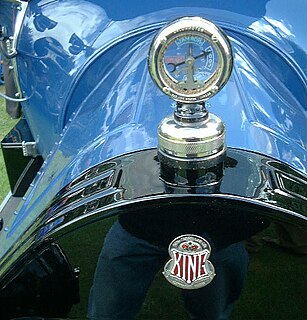
The Star was an automobile marque that was assembled by the Durant Motors Company between 1922 and 1928. Also known as the Star Car, Star was envisioned as a competitor against the Ford Model T.

The Daihatsu Bee is a three-wheeled microcar produced by the Japanese manufacturer Daihatsu from 1951 until 1952.
The Empire Steamer was a steam-driven car designed by William H. Terwilliger of the Empire Auto Company of Amsterdam, New York. Several experimental models were made from 1898 but production only started in 1904. The car had a two-cylinder engine with boiler mounted centrally. the cars were advertised at $2000.

Donnet was a French manufacturing company of the early twentieth century. Founded as Société des Établissements Donnet-Denhaut by Jérôme Donnet and François Denhaut at Neuilly-sur-Seine in 1914, the firm manufactured a highly successful line of patrol flying boats for the French Navy. The company became known simply as Donnet after designer Denhaut left it in 1919, but did not continue to build aircraft for long afterwards.

Gaeth was an American steam automobile manufactured in Cleveland, Ohio from 1902 until 1911.
The Societé Générale des Voitures Automobiles Otto of Paris manufactured the Otto car from 1900 to 1914, and the F.L. from 1909 to 1914.
The Piggins was an American automobile manufactured only in 1909 and a truck, which was marketed as the "Practical Piggins" and manufactured between 1911 and 1916. The passenger vehicle was a six-cylinder touring car of 36 hp or 50 hp. The truck, which had an all-gear drive, was offered with four- and six-cylinder gasoline engines and had an open cockpit situated above the motor. Both vehicles were constructed in Racine, Wisconsin by Piggins Brothers, a business founded by Charles R. Piggins and Frederick H. Piggins.

The Hollier, also known as the Vincent-Hollier, was an automobile built in Chelsea and Jackson, Michigan by Charles Lewis, president of the Lewis Spring and Axle Company from 1915-21. The Hollier was available originally with a V-8 engine of their own design. A later offering, starting in 1917, was powered by a six-cylinder Falls engine. Only open models were built. After the war ended, the company name was changed.
The Jaeger was an automobile built in Belleville, Michigan by the Jaeger Motor Car Company from 1932-33. The Jaeger was powered by a six-cylinder Continental engine, rated at 70 bhp. Wire wheels were standard on the vehicle, with a V-radiator grille and three diagonal groups of four louvers on each side of the bonnet. Only a few coupes and convertible coupes were actually produced. The vehicle sold for $700.

The Marion-Handley was an automobile built in Jackson, Michigan by the Mutual Motors Company from 1916 to 1919. The Marion-Handley was a continuation of the earlier Marion vehicle, and was a popular vehicle. Two models were available, a touring car and a four-seater roadster. The 6-40 model was built on a 10 ft (3,000 mm) chassis, and the 6-60 was offered with a 10 ft 5 in (3,180 mm) chassis. The vehicles came equipped with a Continental six-cylinder engine. Wooden artillery wheels were standard equipment on the touring car, but the touring model offered wire wheels as an option on the roadster.
The M.P.M. was an automobile built in Mount Pleasant, Michigan by the Mount Pleasant Motor Company from 1914 to 1915. The M.P.M. was a medium-sized conventional car equipped with both a four- and eight-cylinder engine. The company had plans to move its manufacturing plant to either Alma or Saginaw at the end of 1915, but the company closed before that happened.
Alphi was a car manufacturer in France from 1929 to 1931. Only four cars were made.

Alva was a range of cars made by Automobiles Alva, Courbevoie, Seine, France from 1913 to 1923.
The Amalgamated was made by the Amalgamated Machinery Corp of Chicago, Illinois, from 1917 to 1919. The Amalgamated Six used a special engine which featured positively opened poppet valves. Instead of disc cams that would only lift, grooved cylindrical cams of the type similar to those in machine tools and other machinery were utilized. Aside from that, the Amalgamated was an assembled car, and only a few were made.

Martini was a pioneer Swiss automobile manufacturer, in operation 1897 to 1934.

The Jackson Automobile Company was an American Brass Era automobile manufacturer located in and named for Jackson, Michigan. The company produced the Jackson from 1903 to 1923, as well as the 1903 Jaxon steam car and the 1904 Orlo.
Continental Motors Company was an American manufacturer of internal combustion engines. The company produced engines as a supplier to many independent manufacturers of automobiles, tractors, trucks, and stationary equipment from the 1900s through the 1960s. Continental Motors also produced automobiles in 1932–1933 under the name Continental Automobile Company. The Continental Aircraft Engine Company was formed in 1929 to develop and produce its aircraft engines, and would become the core business of Continental Motors, Inc.
There were at least three different cars called Pilot. There was a British car built 1909-1914 in London; a US car built 1909-1924 in Richmond, Indiana; and a German car built 1923-1925 in Werdau.

The King was an automobile built in Detroit from 1911 to 1923, and in Buffalo in late 1923, with an additional car built in Detroit in 1896.

The Warren-Lambert Engineering Co. Ltd. was a British automobile manufacturer that was established from 1912 to 1922 in Richmond, then in Surrey. A. Warren Lambert, was an agent for Morgan cars in Putney which he also raced. In 1912 he designed and started to manufacture a two-seat four-wheel cyclecar from premises in Uxbridge Road, Shepherd's Bush. It was well received and around 25 cars a week were being made.













